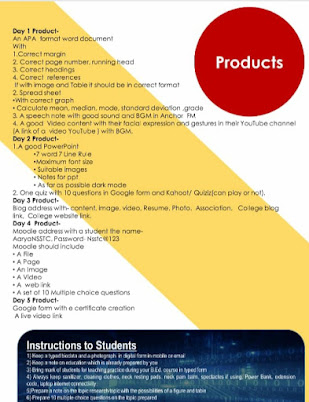THIS IS A ONE WEEK CERTIFICATE COURSE FOR DIFFERENT TYPES OF VARIABLE
SHIBLA EDU WORLD
Friday, February 12, 2021
Thursday, February 11, 2021
MY WORKSHOP PRODUCTS
1.APA FORMATTED WORD FILE
TO DOWNLORD WORD FILE CLICK HERE
2.MY GRADE FILE WITH GRAPH
3.MY VIDEO WITH POWERPOINT
4.MY VIDEO IN KINDMASTER
5.MY AUDIO FILE
TO DOWNLORD CLICK HERE
Wednesday, February 10, 2021
Different types of variable
Independent Variable Definition.
Independent variables are variables that stand on their own and aren’t affected by anything that you, as a researcher, do. You have complete control over which independent variables you choose. During an experiment, you usually choose independent variables that you think will affect dependent variables. Those are variables that can be changed by outside factors. If a variable is classified as a control variable, it may be thought to alter either the independent variable or dependent variable but it isn’t the focus of the experiment.
.
The above graph shows the independent variable of male or female plotted on the x-axis. “Male” or “Female” is unchangeable by you, the researcher, or anything you can perform in your experiment. On the other hand, the dependent variable of “mean vocabulary scores” is potentially changed by which independent variable is assigned. In other words, the mean vocabulary scores depend on the independent variable: whether the participant is male or female.
Another way of looking at independent variables is that they cause something (or are thought to cause something). In the above example, the independent variable is calorie consumption. That’s thought to cause weight gain (or loss).
Dependent variables are factors studied in terms of how they change in relation to independent variables. In a scientific study, the dependent variable is the variable that the researcher is testing and measuring in relation to the independent variable. The researcher is seeking to determine whether or not manipulating the independent variable will lead to different outcomes regarding the dependent variable.
- If a scientist is exploring what factors might lead to changes in a person's weight, then "weight" would be a dependent variable. The researcher could use exact weight in pounds/ounces or grams, or define weight range categories.
- If an educational researcher wants to explore what factors might lead to mastery of Microsoft Excel usage, then "mastery of Microsoft Excel usage" would be a dependent variable. The researcher would need to define mastery, which might be performing certain tasks without error or scoring in a certain range on a test.
Whatever event you are expecting to change is always the dependent variable. In the first example above race performance is the variable you would expect to change if you changed your training, so that’s the dependent variable. In the second example, the dependent variable is weight and in the third example the dependent variable is the amount earned.
If you have trouble figuring out which of your variables is the independent one, and which is the dependent one, try inserting the variables into the following sentence:
“(Independent variable) causes a change in (Dependent Variable) and it isn’t possible that (Dependent Variable) could cause a change in (Independent Variable).”
When you run an experiment (I’m using the word “experiment” here loosely…it could be as simple as taking a survey or it could involve a complex scientific experiment), your independent variable stays fixed. In the next graph, the independent variable(IV) is the grade level and the dependent variable is the food rating. You can see that the food rating depends on what grade a student is (it looks like the higher grade levels have pickier eaters or perhaps students who choose their food more carefully).
Independent and dependent variables always go on the same places in a graph. This makes it easy for you to quickly see which variable is independent and which is dependent when looking at a graph or chart. The independent variable always goes on the x-axis, or the horizontal axis. The dependent variable goes on the y-axis, or vertical axis.
As you can see, this is a graph showing how the number of hours a student studies affects the score she got on an exam. From the graph, it looks like studying up to six hours helped her raise her score, but as she studied more than that her score dropped slightly.
The amount of time studied is the independent variable, because it's what she changed, so it's on the x-axis. The score she got on the exam is the dependent variable, because it's what changed as a result of the independent variable, and it's on the y-axis. It's common to put the units in parentheses next to the axis titles, which this graph does.
There are different ways to title a graph, but a common way is "[Independent Variable] vs. [Dependent Variable]" like this graph. Using a standard title like that also makes it easy for others to see what your independent and dependent variables are.
MODERATING VARIABLE
The term moderating variable refers to a variable that can strengthen, diminish, negate, or otherwise alter the association between independent and dependent variables.For example, in experimental studies, X (independent variable) causes Y (dependent variable).
https://www.google.com/search?q=Extraneous+variable+meaning&sxsrf=ALeKk01yx9-7ksKf4yMe96jWr_krI-3Zdw:1613231912759&tbm=isch&source=iu&ictx=1&fir=ZPzKPmHSGUXXVM%252C6LqyPc7jkEcFIM%252C_&vet=1&usg=AI4_-kRxiaDwaTx6l2Rz849Q2bd8T6tBHw&sa=X&ved=2ahUKEwjsmOaYnefuAhVYaCsKHZfUC8YQ9QF6BAgSEAE#imgrc=ZPzKPmHSGUXXVM
https://www.statisticshowto.com/independent-variable-definition
https://www.statisticshowto.com/independent-variable-definition
FOR ASSESSMENT
Tuesday, February 9, 2021
ABOUT ME
CURRICULUM VITAE
PERSONAL DATA
NAME : SHIBLA NARGHESE V.T
ADDRESS : NSS TRAINING COLLEGE OTTAPALAM
E-MAIL : shibilashibi235@gmail.com
DATE OF BIRTH:24.6.1993
HOBBIES : READING BOOKS ,TRAVELLING
EDUCATIONAL DATA
SHOOLING. : M.E.T.E.M.H.S.S MANNARKKAD.
PLUS TWO : M.E.S HIGHER SECONDARY
SCHOOL (BIOLOGY)
UG. : M.E.S COLLEGE MANNARKKAD
(BA ENGLISH)
P.G. : CALICUT UNIVERSITY
B.ED : SREE NARAYAN COLLEGE
KOTTAPURAM
CERTIFICATE VERIFICATION
THIS IS A ONE WEEK CERTIFICATE COURSE FOR DIFFERENT TYPES OF VARIABLE
-
TYPES OF VARIABLE All experiments examine some kind of variable(s). A variable is not only something that we measure, but also something tha...
-
THIS IS A ONE WEEK CERTIFICATE COURSE FOR DIFFERENT TYPES OF VARIABLE















